-

新人教版高中英语选修2Unit 1 Science and Scientists-Reading and thinking教学设计
Step 5: After learning the text, discuss with your peers about the following questions:1.John Snow believed Idea 2 was right. How did he finally prove it?2. Do you think John Snow would have solved this problem without the map?3. Cholera is a 19th century disease. What disease do you think is similar to cholera today?SARS and Covid-19 because they are both deadly and fatally infectious, have an unknown cause and need serious public health care to solve them urgently.keys:1. John Snow finally proved his idea because he found an outbreak that was clearly related to cholera, collected information and was able to tie cases outside the area to the polluted water.2. No. The map helped John Snow organize his ideas. He was able to identify those households that had had many deaths and check their water-drinking habits. He identified those houses that had had no deaths and surveyed their drinking habits. The evidence clearly pointed to the polluted water being the cause.3. SARS and Covid-19 because they are both deadly and fatally infectious, have an unknown cause and need serious public health care to solve them urgently.Step 6: Consolidate what you have learned by filling in the blanks:John Snow was a well-known _1___ in London in the _2__ century. He wanted to find the _3_____ of cholera in order to help people ___4_____ it. In 1854 when a cholera __5__ London, he began to gather information. He ___6__ on a map ___7___ all the dead people had lived and he found that many people who had ___8____ (drink) the dirty water from the __9____ died. So he decided that the polluted water ___10____ cholera. He suggested that the ___11__ of all water supplies should be _12______ and new methods of dealing with ____13___ water be found. Finally, “King Cholera” was __14_____.Keys: 1. doctor 2. 19th 3.cause 4.infected with 5.hit 6.marked 7.where 8.drunk 9.pump 10.carried 11.source 12.examined 13.polluted 14.defeatedHomework: Retell the text after class and preview its language points

新人教版高中英语选修2Unit 2 Bridging Cultures-Discovering useful structures教学设计
The grammar of this unit is designed to review noun clauses. Sentences that use nouns in a sentence are called noun clauses. Nominal clauses can act as subject, object, predicate, appositive and other components in compound sentences. According to the above-mentioned different grammatical functions, nominal clauses are divided into subject clause, object clause, predicate clause and appositive clause. In this unit, we will review the three kinds of nominal clauses. Appositive clauses are not required to be mastered in the optional compulsory stage, so they are not involved.1. Guide the students to judge the compound sentences and determine the composition of the clauses in the sentence.2. Instruct students to try to learn grammar by generalizing grammar rules, controlling written practice, and semi-open oral output.3. Inspire the students to systematize the function and usage of noun clause1.Instruct students to try to learn grammar by generalizing grammar rules, controlling written practice, and semi-open oral output.2.Inspire the students to systematize the function and usage of noun clauseStep1: The teacher ask studetns to find out more nominal clauses from the reading passage and udnerline the nominal clauses.

新人教版高中英语选修2Unit 3 Food and Culture-Reading and thinking教学设计
The discourse explores the link between food and culture from a foreign’s perspective and it records some authentic Chinese food and illustrates the cultural meaning, gerography features and historic tradition that the food reflects. It is aimed to lead students to understand and think about the connection between food and culture. While teaching, the teacher should instruct students to find out the writing order and the writer’s experieces and feelings towards Chinese food and culture.1.Guide the students to read the text, sort out the information and dig out the topic.2.Understand the cultural connotation, regional characteristics and historical tradition of Chinese cuisine3.Understand and explore the relationship between food and people's personality4.Guide the students to use the cohesive words in the text5.Lead students to accurately grasp the real meaning of the information and improve the overall understanding ability by understanding the implied meaning behind the text.1. Enable the Ss to understand the structure and the writing style of the passage well.2. Lead the Ss to understand and think further about the connection between food and geography and local character traits.Step1: Prediction before reading. Before you read, look at the title, and the picture. What do you think this article is about?keys:It is about various culture and cuisine about a place or some countries.

新人教版高中英语选修2Unit 5 First Aid-Discovering useful structures教学设计
You have no excuse for not going.你没有理由不去。He was punished for not having finished his homework.他因未完成作业而受到惩罚。2.动词ing形式复合结构由物主代词或人称代词宾格、名词所有格或普通格加动词ing,即“sb./sb.'s+doing”构成。动词ing形式的复合结构实际上是给动词ing形式加了一个逻辑主语。动词ing形式的复合结构有四种形式:①形容词性物主代词+动词ing②名词所有格+动词ing③代词宾格+动词ing④名词+动词ingHer coming to help encouraged all of us.她来帮忙鼓舞了我们所有人。The baby was made awake by the door suddenly shutting.这个婴儿被突然的关门声吵醒了。Can you imagine him/Jack cooking at home?你能想象他/杰克在家做饭的样子吗?无生命名词无论是作主语还是作宾语都不能用第②种形式。Tom's winning first prize last year impressed me a lot.汤姆去年得了一等奖使我印象深刻。Do you mind my/me/Jack's/Jack leaving now?你介意我/杰克现在离开吗?Excuse me for my not coming on time.很抱歉我没能按时来。His father's being ill made him worried.他父亲病了,他很担心。We are looking forward to the singer's/the singer to give us a concert.我们盼望着这位歌手来给我们举办一场演唱会。
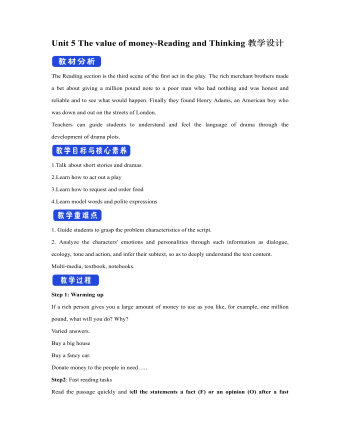
新人教版高中英语必修3Unit 5 The value of money-Reading and Thinking教学设计二
? Could you offer me some kind of work here?? I don’t want your charity, I just want an honest job.? Careless: I landed in Britain by accident.Step 7:Consolidation.? Find Henry? Roderick and Oliver were I .making a bet when they saw Henry, a poor young man. ? Know Henry? About a month ago, Henry was sailing and later he found himself carried out to sea by a strong wind. Fortunately, he 2.was spotted by a ship. And it was the ship that brought him to 3.England? Offer money to Henry ? Oliver and Roderick gave Henry a letter and told him that there was money in it. They 4.persuaded him to accept it, and made him 5.promise that it wouldn't be opened until 2 o'clock.Step 8:Language pointsa large amount of: a large quantity of; a great deal ofe.g. They bought a large amount of furniture before they moved their new house.make a bet: make an arrangement to risk money, etc. on an event of which the result is doubtful.e.g. We made a bet on the result of the match.permit sb to do something: allow somebody to do somethinge.g. My mother doesn’t permit me to ride in the street after it rained.by accident: as a result of chancee.g. I only found it by accident.stare at: look at somebody or something with the eyes wide open in a fixed gaze( in astonishment, wonder, fear, etc)to be honest: to tell you the truth; to be franke.g. To be honest, I don’t think we have a chance of winning.Step7 Homework:What do you think will happen to Henry? Will the bank-note help him or get him into trouble?

新人教版高中英语必修3Unit 5 The Value of Money-Reading for Writing教学设计二
2. 您能看到, 我头发太长了。You can see that my hair is much too long.3. 无论什么时候, 只要您想回来就回来。Please come back whenever you want.4. 您仅有很少的头发要理! You only have too little hair to cut !5. 为您服务是我的荣幸!It is my honour to serve you!Step 9 Writing(Henry is walking down the street when he sees a sign for a place that cuts hair. He decides to have it cut. )H=Henry B=BarberH: Good afternoon, I’d like to have my hair cut, if I may. (The barber looks at Henry’s hair and continues cutting another man’s hair. ) Er, I’d really like a haircut. As you can see it’s much too long. B: (in a rude manner) Yes, I can see that. Indeed, I can. H: Fine, well, I’ll have a seat then. (He sits in one of the barber’s chairs. The barber turns to look at Henry. )B: It’s quite expensive here, you know! Are you sure you can afford it?H: Yes. I think so. (After his hair is cut, the barber tells Henry how much he must pay. Henry shows the barber the bank note. )B: Why Mr. . . (looks shocked)H: Adams. Henry Adams. I’m sorry. I don’t have any change. B: Please don’t worry! (wearing a big smile) Nothing to worry about! Nothing at all! Please come back whenever you want, even if you only have too little hair to cut! It will be my honour to serve you!Step 10 Pair workExchange drafts with a partner. Use this checklist to help your partner revise his/her draft.1. Are all the elements of a play included and in good order ?2. Do the character use suitable language ?3. Are the stage directions clear and useful ?4. Is the plot clear and exciting enough ?

人教A版高中数学必修二简单随机抽样教学设计
知识探究(一):普查与抽查像人口普查这样,对每一个调查调查对象都进行调查的方法,称为全面调查(又称普查)。 在一个调查中,我们把调查对象的全体称为总体,组成总体的每一个调查对象称为个体。为了强调调查目的,也可以把调查对象的某些指标的全体作为总体,每一个调查对象的相应指标作为个体。问题二:除了普查,还有其他的调查方法吗?由于人口普查需要花费巨大的财力、物力,因而不宜经常进行。为了及时掌握全国人口变动状况,我国每年还会进行一次人口变动情况的调查,根据抽取的居民情况来推断总体的人口变动情况。像这样,根据一定目的,从总体中抽取一部分个体进行调查,并以此为依据对总体的情况作出估计和判断的方法,称为抽样调查(或称抽查)。我们把从总体中抽取的那部分个体称为样本,样本中包含的个体数称为样本量。
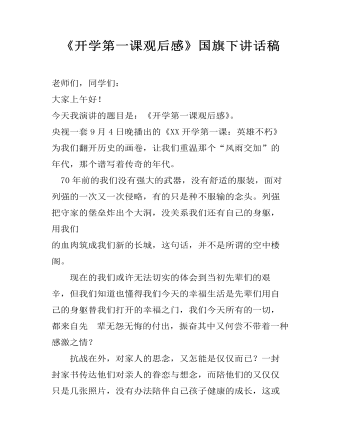
《开学第一课观后感》国旗下讲话稿
老师们,同学们:大家上午好!今天我演讲的题目是:《开学第一课观后感》。央视一套9月4日晚播出的《XX开学第一课:英雄不朽》为我们翻开历史的画卷,让我们重温那个“风雨交加”的年代,那个谱写着传奇的年代。 70年前的我们没有强大的武器,没有舒适的服装,面对列强的一次又一次侵略,有的只是种不服输的念头。列强把守家的堡垒炸出个大洞,没关系我们还有自己的身躯,用我们 的血肉筑成我们新的长城,这句话,并不是所谓的空中楼阁。现在的我们或许无法切实的体会到当初先辈们的艰辛,但我们知道也懂得我们今天的幸福生活是先辈们用自己的身躯替我们打开的幸福之门,我们今天所有的一切,都来自先 辈无怨无悔的付出,振奋其中又何尝不带着一种感激之情?
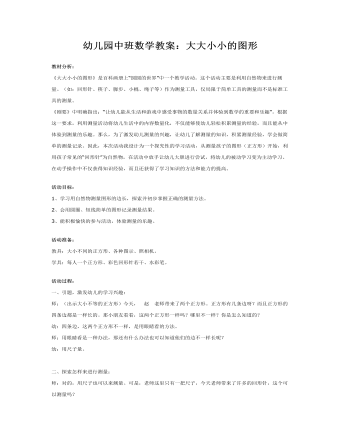
幼儿园中班数学教案:大大小小的图形
《刚要》中明确指出:“让幼儿能从生活和游戏中感受事物的数量关系并体验到数学的重要和乐趣”。根据这一要求,利用测量活动将幼儿生活中的内容数量化,不仅能够使幼儿轻松积累测量的经验,而且能从中体验到测量的乐趣。那么,为了激发幼儿测量的兴趣,让幼儿了解测量的知识,积累测量经验,学会做简单的测量记录。因此,本次活动我设计为一个探究性的学习活动,从测量孩子的图形(正方形)开始,利用孩子常见的“回形针”为自然物,在活动中放手让幼儿大胆进行尝试,将幼儿的被动学习变为主动学习。在动手操作中不仅获得知识经验,而且还获得了学习知识的方法和能力的提高。 活动目标: 1、学习用自然物测量图形的边长,探索并初步掌握正确的测量方法。 2、会用圆圈、短线简单的图形记录测量结果。 3、能积极愉快的参与活动,体验测量的乐趣。 活动准备: 教具:大小不同的正方形、各种图示、照相机。 学具:每人一个正方形、彩色回形针若干、水彩笔。
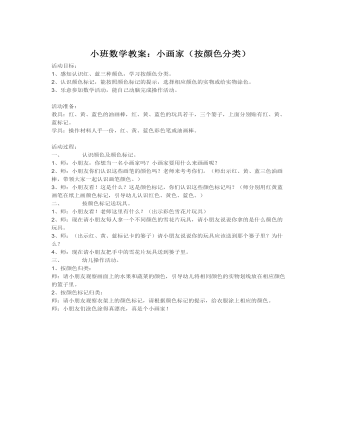
小班数学教案:小画家(按颜色分类)
2、认识颜色标记,能按照颜色标记的提示,选择相应颜色的实物或给实物涂色。 3、乐意参加数学活动,能自己动脑完成操作活动。 活动准备: 教具:红、黄、蓝色的油画棒,红、黄、蓝色的玩具若干,三个篓子,上面分别贴有红、黄、蓝标记。 学具:操作材料人手一份,红、黄、蓝色彩色笔或油画棒。 活动过程: 一、 认识颜色及颜色标记。 1、师:小朋友,你想当一名小画家吗?小画家要用什么来画画呢? 2、师:小朋友你们认识这些画笔的颜色吗?老师来考考你们。(师出示红、黄、蓝三色油画棒,带领大家一起认识画笔颜色。) 3、师:小朋友看!这是什么?这是颜色标记,你们认识这些颜色标记吗?(师分别用红黄蓝画笔在纸上画颜色标记,引导幼儿认识红色、黄色、蓝色。)
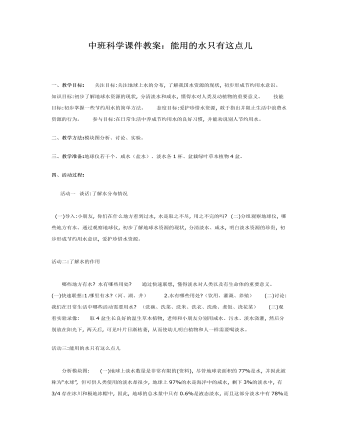
中班科学课件教案:能用的水只有这点儿
二、教学方法:模块图分析、讨论、实验。 三、教学准备:地球仪若干个、咸水(盐水)、淡水各1杯、盆栽绿叶草本植物4盆。 四、活动过程: 活动一 谈话:了解水分布情况 (一)导入:小朋友, 你们在什么地方看到过水, 水是取之不尽, 用之不完的吗? (二)分组观察地球仪, 哪些地方有水。通过观察地球仪, 初步了解地球水资源的现状, 分清淡水、咸水, 明白淡水资源的珍贵, 初步形成节约用水意识, 爱护珍惜水资源。活动二:了解水的作用 哪些地方有水? 水有哪些用处? 通过快速联想, 懂得淡水对人类以及有生命体的重要意义。 (一)快速联想:1.哪里有水?(河、湖、井) 2.水有哪些用处?(饮用、灌溉、养殖)
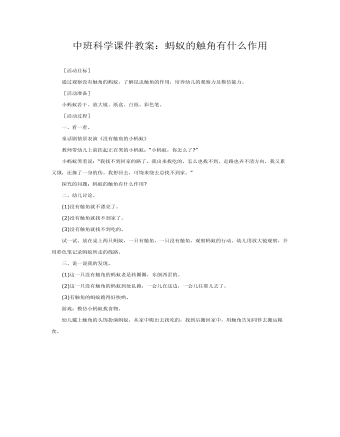
中班科学课件教案:蚂蚁的触角有什么作用
[活动准备] 小蚂蚁若干、放大镜、纸盒、白纸、彩色笔。 [活动过程] 一、看一看。 童话剧情景表演《没有触角的小蚂蚁》 教师带幼儿上前扶起正在哭的小蚂蚁:“小蚂蚁,你怎么了?” 小蚂蚁哭着说:“我找不到回家的路了。我出来找吃的,怎么也找不到,走路也弄不清方向,我又累又饿,还撞了一身的伤。我想回去,可绕来绕去总找不到家。” 探究的问题:蚂蚁的触角有什么作用? 二、幼儿讨论。(1)没有触角就不漂亮了。(2)没有触角就找不到家了。

大班科学课件教案:使用我们身边的工具
活动目标:1、通过交流展示各种工具,初步感受工具的种类很多。2、在观察操作尝试中感知工具的作用很大,发展综合能力。3、能积极参与活动,在活动中体验观察和探索的乐趣。 活动准备:1、课前幼儿收集各种工具。老师和幼儿到室外寻找特殊的工具。2、卷笔刀、削苹果机,刨子,开瓶器。以及相对应的辅助用品。 活动过程:一、尝试操作使用工具1、师:“前几天老师和大家一起收集了各种各样的工具,今天让我们就来试试这些工具,看看它们有什么用。” (幼儿分别操作工具,提醒幼儿注意安全)
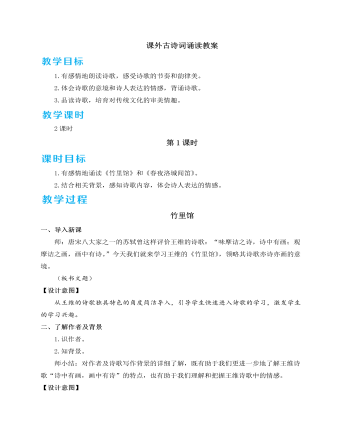
人教部编版七年级下册课外古诗词诵读教案
四、品读揣摩诗歌情志1.读出意境画面。师:请同学们以小组为单位,齐声朗读诗歌,然后合作交流,探究下面问题。(1)诗人用了哪些意象来表现晚春景色?诗人用了什么手法来写晚春景物?取得了怎样的艺术效果?(2)诗歌一、二句写出了怎样的晚春景致?请同学们用自己的语言描绘出来。(3)诗的三、四句意蕴深刻,为历代传诵。请从修辞手法的角度对这两句诗进行赏析。(生齐读后,小组交流、讨论问题,师指导明确)预设 (1)诗人用了草树、杨花、榆荚等意象表现晚春景色。一个“斗”字,运用拟人的修辞手法,把花朵人格化,形象生动地写出了晚春时节花草树木争芳斗艳的美丽景象。花草树木仿佛都有了情思,有了个性,成了精灵,使描绘的晚春景致生动而有情趣。
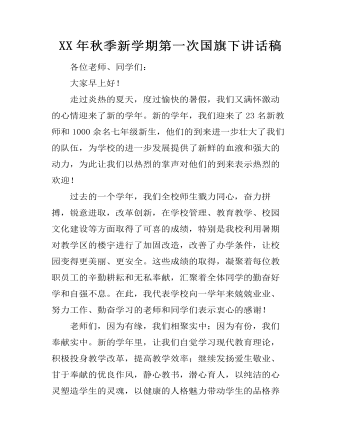
XX年秋季新学期第一次国旗下讲话稿
各位老师、同学们:大家早上好!走过炎热的夏天,度过愉快的暑假,我们又满怀激动的心情迎来了新的学年。新的学年,我们迎来了23名新教师和1000余名七年级新生,他们的到来进一步壮大了我们的队伍,为学校的进一步发展提供了新鲜的血液和强大的动力,为此让我们以热烈的掌声对他们的到来表示热烈的欢迎!过去的一个学年,我们全校师生戮力同心,奋力拼搏,锐意进取,改革创新,在学校管理、教育教学、校园文化建设等方面取得了可喜的成绩,特别是我校利用暑期对教学区的楼宇进行了加固改造,改善了办学条件,让校园变得更美丽、更安全。这些成绩的取得,凝聚着每位教职员工的辛勤耕耘和无私奉献,汇聚着全体同学的勤奋好学和自强不息。在此,我代表学校向一学年来兢兢业业、努力工作、勤奋学习的老师和同学们表示衷心的感谢!老师们,因为有缘,我们相聚实中;因为有份,我们奉献实中。新的学年里,让我们自觉学习现代教育理论,积极投身教学改革,提高教学效率;继续发扬爱生敬业、甘于奉献的优良作风,静心教书,潜心育人,以纯洁的心灵塑造学生的灵魂,以健康的人格魅力带动学生的品格养成,营造我校和谐健康,洋溢着人文色彩的人际氛围,努力实践教育促进人的发展的崇高目标。
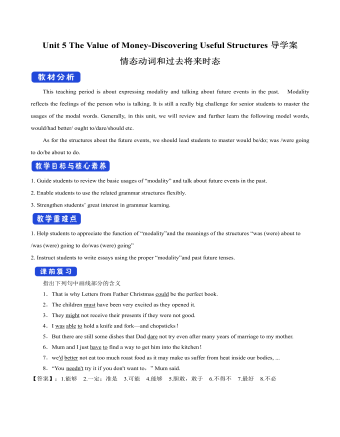
新人教版高中英语必修3Unit 5 The Value of Money-Discovering Useful Structures导学案
4.They were going to find someone to take part in their bet when they saw Henry walking on the street outside.[归纳]1.过去将来时的基本构成和用法过去将来时由“would+动词原形”构成,主要表示从过去某一时间来看将要发生的动作(尤其用于宾语从句中),还可以表示过去的动作习惯或倾向。Jeff knew he would be tired the next day.He promised that he would not open the letter until 2 o'clock.She said that she wouldn't do that again.2.表示过去将来时的其他表达法(1)was/were going to+动词原形:该结构有两个主要用法,一是表示过去的打算,二是表示在过去看来有迹象表明将要发生某事。I thought it was going to rain.(2)was/were to+动词原形:主要表示过去按计划或安排要做的事情。She said she was to get married next month.(3)was/were about to+动词原形:表示在过去看来即将要发生的动作,由于本身已含有“即将”的意味,所以不再与表示具体的将来时间状语连用。I was about to go to bed when the phone rang.(4)was/were+现在分词:表示在过去看来即将发生的动作,通常可用于该结构中的动词是come,go,leave,arrive,begin,start,stop,close,open,die,join,borrow,buy等瞬间动词。Jack said he was leaving tomorrow.
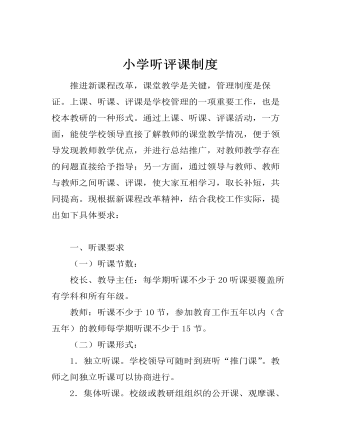
小学听评课制度
一、听课要求 (一)听课节数: 校长、教导主任:每学期听课不少于20听课要覆盖所有学科和所有年级。 教师:听课不少于10节,参加教育工作五年以内(含五年)的教师每学期听课不少于15节。 (二)听课形式: 1.独立听课。学校领导可随时到班听“推门课”。教师之间独立听课可以协商进行。 2.集体听课。校级或教研组组织的公开课、观摩课、汇报课等。 3.外出学习听课。 (三)听课要求: 1.听课前,原则上应该先自行调好自己的课程,如有自己解决不了的问题请教导处协调,千万不能因教师听课而耽误学生的学习。 2.教研组以上的集体听课,教研组长及所在班的班主任应协助做好听课准备工作,如时间的安排、地点的安排、电教设备、学生的准备等。 3.听课时,教师要提前5分钟进入教室,不讲话、不走动、关闭通信工具。如无特殊情况不中途离场,以示对执教者的尊重。 4.要认真做好听课记录。教师要做好详细记录,所有听课者都应写听课简评。
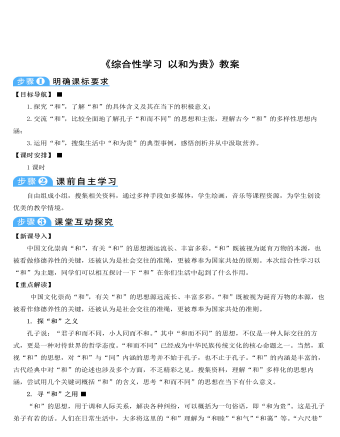
部编版语文八年级下册《综合性学习:以和为贵》教案
【目标导航】1.探究“和”,了解“和”的具体含义及其在当下的积极意义;2.交流“和”,比较全面地了解孔子“和而不同”的思想和主张,理解古今“和”的多样性思想内涵;3.运用“和”,搜集生活中“和为贵”的典型事例,感悟剖析并从中汲取营养。【课时安排】1课时自由组成小组,搜集相关资料,通过多种手段如多媒体,学生绘画,音乐等课程资源,为学生创设优美的教学情境。【新课导入】中国文化崇尚“和”,有关“和”的思想源远流长、丰富多彩。“和”既被视为诞育万物的本源,也被看做修德养性的关键,还被认为是社会交往的准绳,更被尊奉为国家共处的原则。本次综合性学习以“和”为主题,同学们可以相互探讨一下“和”在你们生活中起到了什么作用。
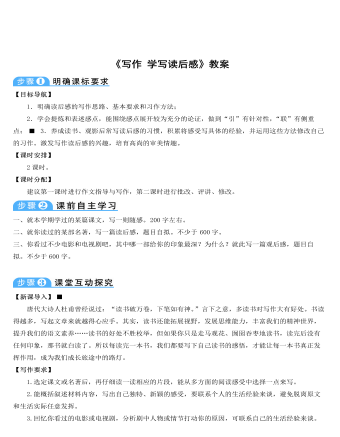
部编版语文八年级下册《写作:学写读后感》教案
【新课导入】唐代大诗人杜甫曾经说过:“读书破万卷,下笔如有神。”言下之意,多读书对写作大有好处。书读得越多,写起文章来就越得心应手。其实,读书还能拓展视野,发展思维能力,丰富我们的精神世界,提升我们的语文素养……读书的好处不胜枚举,但如果你只是走马观花、囫囵吞枣地读书,读完后没有任何印象,那书就白读了。所以每读完一本书,我们都要写下自己读书的感悟,才能让每一本书真正发挥作用,成为我们成长旅途中的路灯。【写作要求】1.选定课文或名著后,再仔细读一读相应的片段,能从多方面的阅读感受中选择一点来写。2.能概括叙述材料内容,写出自己独特、新颖的感受,要联系个人的生活经验来谈,避免脱离原文和生活实际任意发挥。3.回忆你看过的电影或电视剧,分析剧中人物或情节打动你的原因,可联系自己的生活经验来谈。【技法点拨】
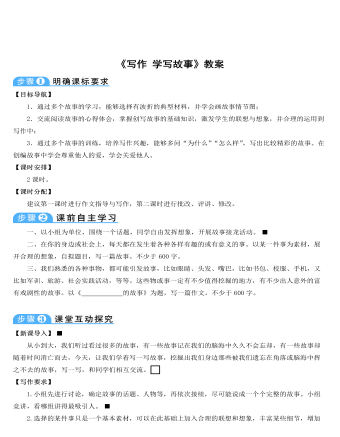
部编版语文八年级下册《写作:学写故事》教案
【目标导航】1.通过多个故事的学习,能够选择有波折的典型材料,并学会画故事情节图;2.交流阅读故事的心得体会,掌握创写故事的基础知识,激发学生的联想与想象,并合理的运用到写作中;3.通过多个故事的训练,培养写作兴趣,能够多问“为什么”“怎么样”,写出比较精彩的故事。在创编故事中学会尊重他人的爱,学会关爱他人。一、以小组为单位,围绕一个话题,同学自由发挥想象,开展故事接龙活动。二、在你的身边或社会上,每天都在发生着各种各样有趣的或有意义的事。以某一件事为素材,展开合理的想象,自拟题目,写一篇故事。不少于600字。三、我们熟悉的各种事物,都可能引发故事,比如眼睛、头发、嘴巴,比如书包、校服、手机,又比如军训、旅游、社会实践活动,等等。这些物或事一定有不少值得挖掘的地方,有不少出人意外的富有戏剧性的故事。以《 的故事》为题,写一篇作文。不少于600字。


